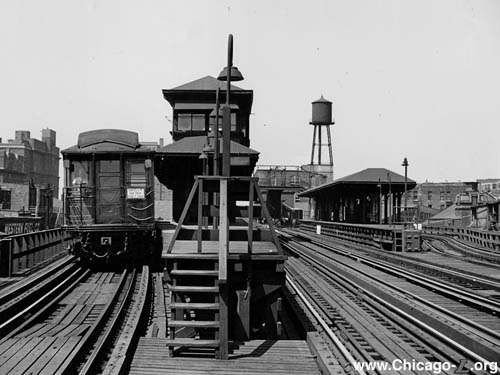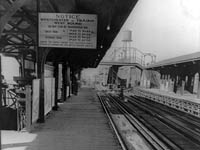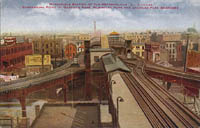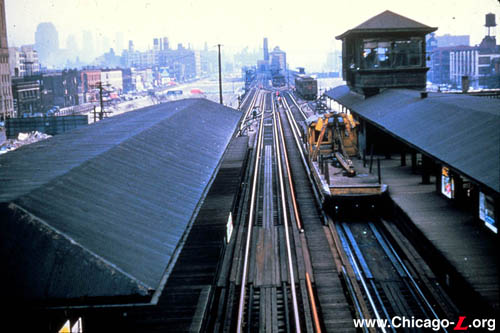|

Marshfield station is seen looking west in 1946 as an inbound Garfield Park train stops at the station The south platform, in the center foreground, served Garfield Park and Douglas Park trains, while the north platform, in the right background, served Logan Square and Humboldt Park trains. The interlocking tower over the south platform controlled the junction beyond the station and the interlocking behind the photographer. For a larger view, click here. (Photo by Charles E. Keevil)
|
Marshfield
(1700W/400S)
Marshfield Avenue and
Paulina Street, Near West Side
Service
Notes:

|
Garfield
Line/Douglas Line
|
Quick Facts:
Address: 418 S. Marshfield Avenue
Established: May 6, 1895
Original Line: Metropolitan West Side Elevated Railroad
Previous Names: none
|
Skip-Stop Type:
|

|
Station
|
Rebuilt: n/a
Status: Demolished
History:

The Marshfield station is seen looking west on the south platform. Note that the overhead transfer bridge in the background doesn't have a roof for reasons that are unclear. The oversized sign under the canopy describes the Westchester Express service. For a larger view, click here. (Photo from the CTA Collection) |
The Marshfield station was opened in 1895 when the Metropolitan
"L" first opened. It was the last station on the Met main line before it
divided into three separate branches: the Northwest
branch, Garfield Park
branch, and Douglas
Park branch.
The Marshfield Junction was a complicated place indeed. East of
the station, just after the Laflin stop,
trains crossed over a segment where two inbound and two outbound
tracks become two paralleling double-tracks. Originally, Garfield
Park and Douglas
Park trains used the set of tracks on the south side; Logan
Square and Humboldt
Park trains used the set to the north. This arrangement carried
over to Marshfield's dual island platforms, where those bound
for the northwest branches used the north platform while those going to points west and
southwest used the south platform. Immediately west of the station, the tracks forked into a Y with
three two-track lines (cutting the roof of the Dreamland Dance Hall
below into three slices) going north (Humboldt
Park and Logan
Square), west (Garfield
Park) and south (Douglas
Park). An interlocking tower was located at the east end of the south platform to control this
junction. Enclosures were located at the west end of both platforms, under the canopies, which may have been waiting rooms or company offices. A station house was located at street level on the west side of Marshfield Avenue.

This postcard looks east at Marshfield station and junction. The single platform in the foreground was used by outbound CA&E interurbans. The Met "L"stopped at dual platforms beyond the transfer bridge. For a larger view, click here. (Postcard from the Graham Garfield Collection) |
Marshfield station was modified several times over the following decades. The Chicago Aurora & Elgin interurban, which used the Garfield Park branch to reach downtown Chicago through a reciprocal trackage rights agreement, also served Marshfield station from February 23, 1905 to September 20, 1953. The station was modified for CA&E service, with westbound interurban trains stopping not at the "L" platform but at a new side platform that was added west of the junction. A pedestrian transfer bridge was added at the west end of the "L" platforms connecting the two, with a third stair from the middle of the bridge connecting to the CA&E platform. A building was located at the east end of the interurban platform, possibly housing CA&E ticket offices or other methods of regulating traffic between the CA&E and "L" platforms. Eastbound CA&E interurban trains discharged passengers at the eastbound "L" platform to provide cross-platform transfers for many decades until the stop for rush hour trains was relocated from Marshfield to Ogden at the request of the CTA to clear up delays at Marshfield Junction. Boarding eastbound CA&E trains at Marshfield was prohibited.
The relatively short island "L" platforms were also lengthened over the years. Because of the junction to the west, the platforms were extended to the east, eventually enveloping the first floor of the interlocking tower in the case of the south platform.
In 1951, trains to and from Logan
Square were rerouted from their Milwaukee-Paulina alignment to Marshfield
into the Milwaukee-Dearborn
Subway, which continued under Milwaukee, under Lake Street, then
under Dearborn, later connecting to the Congress-Douglas trains under
Congress Street upon that alignment's completion in 1958. Garfield
Park and Douglas
Park trains to and from the Loop,
however, continued to operate over the old Met
main line and through Marshfield for the time being.
In 1953, the Garfield
Line was rerouted via temporary grade-level trackage along Van
Buren due to expressway construction, vacating the elevated and
discontinued calling at Marshfield station. Marshfield was closed in
1954 when the Douglas
Line was temporarily rerouted via the Lake Street "L" to the
Loop. The old Garfield
Park elevated was dismantled to allow the construction of the
Congress Street Expressway (later called the Eisenhower Expressway)
and the replacement Congress
"L" Line in the median. No station was built as a direct replacement for
Marshfield, though the Paulina entrance to the Medical Center station was just a block west of the former Marshfield station. Today, the Douglas branch connects to the Congress branch of Blue
Line roughly where Marshfield station formerly stood.
|

Marshfield is seen looking east from the overhead transfer bridge in the early 1950s as a work train sits in the station on the outbound Garfield/Douglas track. In the background, just beyond the inbound two-car wooden "L" train, the crossover where two inbound and two outbound tracks become two paralleling double-tracks is visible. The interlocking tower looms over the south platform. For a larger view, click here. (Photo from the Graham Garfield Collection)
|






